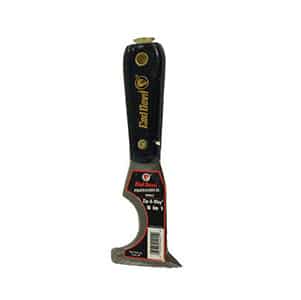Last updated: 1 May 2023
If I were stranded on a desert island and had to choose only one tool, it wouldn’t be a knife, magnifying glass, or even a Leatherman’s multi-tool. I’d choose a 5-in-1 or X-in-1 painters tool. This versatile tool may not look like much, but it has given me more value than any other three tools combined. It has endless uses, making it an indispensable tool for tradespeople, DIYers, and homeowners alike. With no fixed name, this simple tool can be a game-changer and a valuable addition to your toolkit.
Read as I count down the 10 most important uses for this tool and especially stick around for the last one. Because it is by far my most important use for this tool as a carpenter. People mostly call this thing a painter’s tool. Let’s start with some painting functions.
Roller Cleaning
Paint rollers can carry more than half a pint of paint in the nap. And even when you’re done rolling a lot of this paint is still in there. So painters use this tool to squeeze out the excess paint. It just forces the paint out in a smooth raising motion. You can spin the roller and work on all surfaces.
Then after you rinse the roller you can use it to squeeze out the excess water and repeat. It works for both full-sized rollers and mini rollers so it’s a great way to prolong the lifespan of your painting tools.
Opening Paint Cans
The flat head on the back of the tool is perfect for prying up paint can lids. Simply slot it in, give the handle a little pry, and pop the lid out. Alternatively, you can work the tool around the rim like a can opener and the lid will lift off easily without bending it. This tool is also useful for closing paint cans, especially those with excess paint.
Hammer Striking
Most of these 5-in-1 painter’s tools now come with a little metal but down on the end of the handle. This primarily for driving paint can lid back down into place. Just a few quick taps around the perimeter will give you a flush seal. I wouldn’t be tempted to use it for any other type of hammering certainly not driving nails just doesn’t have the force or accuracy for that. But if you’re on the job site you just need to give something a hard knock to dislodge it you can use it for that.
Paint Scraping
The body of the tool is very thin. Just over a sixteenth of an inch. And the top has this really wide beveled surface. These features combined make this the ultimate paint scraping tool. By placing the bevel face down and driving the tool forward at a very low angle you can scrape and probably even the most stubborn paint chips.
You can also use the back of the bevel at a steeper angle in a raking motion. The harsh friction will plow up loose paint surfaces knocking chips away. It’s also great for scraping caulk off the edge of trim pieces. Just be sure to not dig too deeply and begin prying up wood. This use is so ubiquitous that some people just call this thing a scraper.
Corner Gouging
The tool head also has a blunt dagger point on the other end. This is perfect for raking out corners where two surfaces meet. You can just draw the tool down with a lot of pressure and it’ll slash and force material out of that gap. You can also use this little point as a pick for wrangling material up so you can scrape it out later. And keep in mind this doesn’t have to just be for paint removal. You can use the carve-out dirt or nearly anything else launched in a corner.
Spreading Putty
The beveled face of a painters tool is also excellent for use as a putty knife. You can use it to trowel spackle wood filler. The wide blade creates a lot of surface area and the sharp edge gives you a fine sturdy point of control. Just remember to clean the tool off before going on to use it for other things. Some harder wood fillers can gunk it up. Those are pretty much all the paint-related uses. But I’m a professional DIYer I don’t paint all that often. And yet I always have a painter’s tool or 5-in-1 with me in my tool belt.
Nail Prying
Some models now come with this little teardrop shape up near the bevel. This for prying small nails. You just hook the wide part of the hole over the fastener head, pull it down snug then pry up gently. This is only effective for really small fasteners that aren’t lodged it into hard. The tool isn’t quite strong enough to pull out large fasteners.
Surface Protection
Hammers are the handiest tools for prying out nails. But you should never pry too hard on vulnerable surfaces like trim or drywall. And this because you can damage them so easily.
The typical way to avoid this is to slip something thin and hard like eighth-inch plywood behind the hammerhead to protect that vulnerable surface. But you won’t always have a piece of thin plywood handy on the job site. So in a pinch, I just use my 5-in-1. I get my hammer claw set underneath the fastener then slip the 5-in-1 underneath the hammerhead.
Now this gives me a surface to pry back on with the hammer.
The wide blade and softer handle the 5-in-1 often give just enough support to spread the weight further across the surface of the wall. Thereby preventing noticeable damage. And you can use it anywhere you want to pry something in this fashion hardwood floors linoleum. Just don’t go overboard with hard leverage and this method will speed things up while protecting those more pristine surfaces.
Light Chiseling
I wouldn’t use this tool for heavy chiseling work. But if I already have my 5-in-1 out I’ll sometimes use it for splitting wood or breaking apart other materials. The plate is way harder than it looks and the tool is pretty stiff. So striking it like a chisel with my hammer I can use it to cut into end grain which is susceptible to splitting. Or I’ll even sometimes used to split the face grain on softer woods like pine and poplar when I’m working purely on demolition. Failing that I’ll usually just switch right over to large screwdriver.
Prying Apart Materials
This tool is prying apart materials. Controlled demolition is the key to saving money preserving materials and making repair jobs go smoothly. But most of our demolition tools work by brute force. They’re blunt and heavy and they leave a lot of scarring on the materials they come in contact with.
The 5-in-1 or painters tool is the most delicate demolition tool ever invented. It’s incredibly thin but it’s also extremely stiff. This means that you can wedge it or tap it into the tiniest crevices without causing damage to the surface material on either side. I really can’t explain how invaluable this is to a DIYer.
When I need to remove any kind of trim or separate two materials, I always start with the 5-in-1 tool. I gently tap it with a hammer to wedge it between the surfaces, and then I apply pressure to pry them apart.
Other tools just don’t handle this task very well. I have large pry bars and tiny trim pry bars and they’re all great for various phases of demolition, but they’re all just too thick. When you force them into a small gap they ruin all the surfaces around your work area. And we’ll take a ton of force to get them driven in sometimes.
If you’re trying to reuse the trim or other building materials involved they’re now going to have gashes and notches all over them. Trim removed with a 5-in-1 we’ll just have tiny little scars they can easily be hidden with caulk and paint.
It’s also a great tool for probing. When I have a small gap open up I’ll sometimes run the skinny blade of the 5-in-1 up and down that gap and feel for fasteners.
Final Thoughts
If you’re just now about to start the demolition phase I highly recommend that you have a 5-in-1 on hand at pretty much all times. Any light work especially around trim and casings should typically begin with a 5-in-1 and utility knife. The possibilities of painter’s tools are seemingly endless and more just keep coming all the time.
Painters multi-tool is so flexible and yet so reliable that it really might be the most useful tool in the world. But that’s just one DIYers opinion.
If you disagree what is 5-in-1 is a better tool out or do you use this tool for things that I didn’t even mention let me know down in the comments section. As always thanks for reading.






Eric says
Awesome tool!!